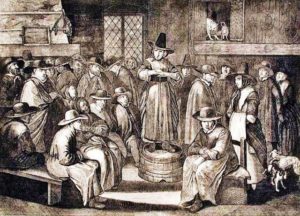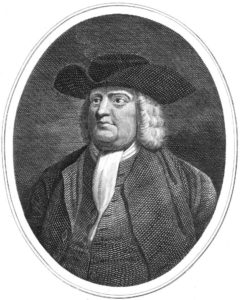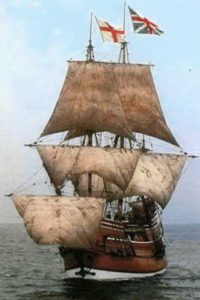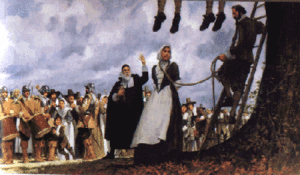If you’ve been following the Pierce family history, you will by now have come to the realization that our Pierce Family were mostly Quakers that immigrated in the early days of our country. When researching the Pierce family you will find them among the records of the Quakers, or other wise known as the Religious Society of Friends, and also referred to as the Quaker Movement. It was founded in England in the 17th century by George Fox. He and other early Quakers, or Friends as they were called, were persecuted for their beliefs, which included the idea that the presence of God exists in every person. Quakers rejected elaborate religious ceremonies and didn’t have official clergy. They believed in spiritual equality for men and women. Quaker missionaries first arrived in America in the mid-1650s as did our first Pierce Ancestor, George Pierce. Quakers, who practice pacifism, played a key role in both the abolition and women’s rights movements.
George Fox
In the 1640s, George Fox, a reasonably young man left his home in the English Midlands and traveled around the country on a spiritual quest. It was a time of religious turmoil in England as well as other areas, with people seeking reform in the Church of England or starting their own churches.
Over the course of his journey, as Fox met others searching for a more direct spiritual experience, he came to believe that the presence of God was found within people rather than in churches. He experienced what he referred to as “openings,” instances in which he felt God was talking directly to him.
Fox shared his beliefs with others and spoke to increasingly larger gatherings. Even though his views were viewed by some as a threat to society and he was jailed for blasphemy in 1650, Fox and other early Quakers continued to share their beliefs. In 1652, he met Margaret Fell, who went on to become another leader in the early Quaker movement. Her home was at Swarthmoor Hall in Northwest England and served as a gathering place for many of the first Quakers. Fox and Fell married in 1667.
“Quaker” emerged as a nickname for Fox and others who shared his beliefs. The group eventually accepted the term, although their official name became Religious Society of Friends. Members are referred to as Friends or Quakers.
What Is a Quaker?
Quakerism continued to spread across Britain during the 1650s, and by 1660 there were around 50,000 Quakers, according to some estimates.
A number of Quaker beliefs were considered radical, such as the idea that women and men were spiritual equals, and women could speak out during worship. Quakers didn’t have official ministers or religious rituals. They opted not to use honorific titles such as “Your Lordship” and “My Lady.”
Based on their interpretation of the Bible, Quakers were pacifists and refused to take legal oaths. Central to their beliefs was the idea that everyone had the Light of Christ within them.
During the 1680s thousands of Quakers were persecuted and jailed. Fox spent much of the 1660s behind bars.

RECORD KEEPERS
The basic unit in the organization of the Society of Friends is the Monthly Meeting, which receives, transfers and dismisses members, provides for the oversight of marriages and funerals, and deals with those who
depart from Friends’ principles and testimonies. The term Monthly Meeting may be applied either to the actual membership or to the monthly business sessions.
The Preparative Meeting is a constituent part of the Monthly Meeting and is subordinate to it. The Preparative Meeting holds business sessions to formulate recommendations to be acted upon by the Monthly Meeting. In the early periods of Quakerism, Monthly Meetings frequently included several congregations scattered over a large area, and the Preparative Meeting included one or more neighboring congregations.
Within these meetings some of the best records have been kept. Having a Quaker ancestor is a God send when researching your ancestors as you have access to some of the best records. George Fox established a rich system of record keeping.
Penn Quakers
Quaker missionaries arrived in North America in the mid-1650s.The first was Elizabeth Harris, who visited Virginia and Maryland. By the early 1660s, more than 50 other Quakers had followed Harris.
However, as they moved throughout the colonies, they continued to face persecution in certain places, such as Massachusetts, where four Quakers were executed.
In 1681, King Charles II gave William Penn, an English Quaker, a large land grant in America to pay off a debt owed to his family. We know from previous research that our George Pierce purchased land from Penn. Penn, who had been jailed multiple times for his Quaker beliefs, went on to found Pennsylvania as a sanctuary for religious freedom and tolerance.
 HUGH ROBERTS
HUGH ROBERTS
Another of our ancestors, that being Hugh Roberts, (my 7th great grandfather) was among the 2nd Welsh party from Merionethshire, member of the Penllyn Month Meeting, who were purchasers of land in the “Thomas and Jones Tract,” This party is known as the “Hugh Robert’s party”, that came over in the ship Morning Star, of Chester. Thomas Hayes (of our Hayes line??? I’m not yet sure) was the master of the ship, sailing from Mosson, in September of 1683. The voyage took two months, and was described as uneventful with the exception of several burials at sea. They arrived in the Delaware, and at Philadelphia in the mid part of November.
The passenger list was large, outside of the Roberts’ party, in which there were 50 or more persons including servants, Welshmen and their families coming over to settle somewhere in the great Welsh Tract. “Divers of those early Welsh settlers were persons of excellent and worthy character, and several of good education, family, and estate.” as they were descriptively noted by Proud.
Some noted names in this party were :
Hugh Roberts, Edward Owen, William John, Gainor Roberts (sister of Hugh) Cadwalader Morgan, Hugh John, and Katherin Thomas.
Hugh Roberts of Kiltalgarth, yoeman (meaning freeman), headed the second party of settler’s from Merionethshire bound for the Thomas and Jones tract. In his immediate party, were is mother, his wife, his sister, Gainor Roberts, five children, and four servants.
Hugh was a man of education and an eminent minister among Friends, whom he joined in 1666, and described as a a “pleasant writer”. Not much is known of his ancestry, except that he was the son of Robert Hugh (eight great grandfather), Or “Robert Pugh, gent” of Llyndedwydd, a leased farm, near Bala, and the Lake, in Penllyn, Merioneth, by his wife Katherine Roberts (eight great grandmother), who being a widow at the time of the removal, came with her son to Pennsylvania, and is buried at the Merion Meeting, in 1699. Katherine was the daughter of William Owen (9th great grandfather), of Llanvawr parish, in Penllyn where Hugh Roberts lived before he set out for America.
Hugh Roberts, being so prominent and a minister of Friends’, in North Wales, suffered fines, annoyances, and imprisonment. He brought a certificate of membership, for his wife and family as well as for himself from the Men’s Meeting in Penllyn, Merioneth, dated 2 5mo 1688.
Hugh soon became well known in America as a travelling public minister, and in 1688 and 1697 and 98 he made missionary visits to North Wales. On his last trip, he kept and interest journal of his travels, beginning on Feb 15 1697. This trip took him to England and Wales by the way of Maryland and Virginia.
This journal is printed in full in the periodical of the Historical Society of Pennsylvania and begins like this:
“In the year 1697 the 15th of ye mo. I set out from home to visit Friends in England and Wales, Samuel Carpenter and John Ascue accompanying me to Maryland.”
He held meetings along the way and in Maryland visited Mordecai Moor, Samuel Galloway, David Rawlins, and the widow Blackstone, “who was no Friend.” From her home, where he stayed for two days, he went to the Rapahannock river, alone he walked through the woods to “one Captain Taylor, who was very kind to me.” From there he he traveled “to a friend, George Wilson, a place where I had been before.”
“Here I had a very open Meeting amongst ye people of ye world.”
From there we went on to New Kent county, “Where there is a meeting of Friends,” and the next day to a Monthly Meeting at Curles on James river, “met dear James Dickinson,” “and I went to Edward Thomas at James river, Charles Fleming coming along with me” and attended a Quarterly Meeting at Tenbigh. Then he visited Alexander Llewellyn.
“We traveled that same day 46 miles, besides keeping ye Meeting, and it was not hard for us to do because ye Melting love and power of God was set over all.”
From this Welsh settlement Hugh went over the James river to Walter Bartlet’s, “and so on the Sevenech, where I had a good meeting at ye Meeting house.”
He visited the homes of Henry Wiges, William Cook, Richard Ratcliff, Daniel Sanburn, and John Coopland, and held a Meeting at Chuckatuck.
He also went to the homes of William Scott, Leven Buffstin, Elizabeth Gallowell, and Elizabeth Hollowell, having Meetings in each house.
“From thence on board ye ship, which was to ye mouth of James river, where ye Fleet met, we stayed on board 15 days before we sailed, and had several Meeting from ship to ship, and upon ye 7th day of ye 3d month we sailed.”
Hugh next saw land on 17 of July and arrived at Plymouth on the 22.
Once again on land Hugh continued his travels in England and at Bristol, “we met our dear friend William Penn, and were not a little glad to see one another.”
Entering Wales, he visited several Meetings, one at “Trefrug, where John Bevan liveth, and glad we were to meet one another.”
Together with his friend they made the rounds of many Meetings, at James Lewis’s Rediston; at Own Bowen’s, near Carmarthin ; at James Preece’s, City Boom.
In Radnorshire he visited Roger Hughes: From North Wales he traveled to many places in South Wales visiting friends Edward Jones, David Powel, and Thomas Gooin near Liwyn-du. “Penllyn where I was born and bred,” and there he visited Lewis Owen, near Dollegelly, then to Bala, and old friend, Robert Vaughn, and then made another trek through Wales.
GATHERING OF THE LAND
Upon his return he brought with him a large party of people from Merioneth, and North Wales, Many died at sea. He arrived at Philadelphia and settled the surviving emigrants, some in Merion, and others at Gwynedd, which he is considered the founder.
The Pennsylvania land record of his day show that he was a land speculator as well as a minister, to the day of his death. He bought and sold many parcels of land during his years. At one time he had total 1349 3/4 acres in Merion, and tracts of land in the townships of Duffryn Mawr, and Goshen, on Ridley Creek.
It has been said that Hugh Roberts died at the house of John Redman, in Long Island, New York, while on a visit in August 1702 and that his remains were brought over from Long Island and buried at the Merion Meeting House “after a large meeting was held.”
A letter from Judge Isaac Norris to Jonathan Dickinson provides evidence that it is probable that he actually died at home in Merion. The entry in the Merion Meeting minutes is “Hugh Roberts departed this life 6m 18 1702.” (Aug 18 1702)
In his will proved 7 December 1702 he names his children, and distributed about 1200 acres in Merion, and 1100 acres in Goshen township, a meadow called “Clean John”. He bequeathed 5 lbs to the Merion Meeting. He mentions his servants, Morris Robert, and John Robert, and boys, Griffth and Morris. His trustees were John Roberts, Cadwalader Morgan, Griffith Jon, and Griffith Owen. Witnesses: Samuel Bowne, Griffith Owen, and Samuel Jennings.
Hugh Roberts married twice. His first wife, Jane Owen daughter of Owen Even Robert Lewis, off Fron Goch, in Merioneth. She was the sister of Robert Owen, Of Merion and she came to Merion with him and brought the certificate mentioned above. Jane died September 1, 1686, and was buried at the Merion Meeting House.
His second wife, Elizabeth John or Jones, (some changed the name John to Jones after the move), he married at the Llwyn-y- Braner Meeting in Penllyn, Merionethshire, when on a visit.
Hugh and Jane had six children. Jane was of Royal Descent, and assumed the surname Roberts.
- Robert Roberts (my 6th great grandfather) was born 7 Jan 1678
- Ellin Roberts born 4 Dec 1675
- Owen Roberts born 1 Dec 1677
- Edward Roberts born 4 Apr 1680
- William Roberts born 26 May
- Elizabeth Robert born 24 Feb 1683
Within just a few years, several thousand Friends had moved to Pennsylvania from Britain.
Quakers were heavily involved in Pennsylvania’s new government and held positions of power in the first half of the 18th century, before deciding their political participation was forcing them to compromise some of their beliefs, including pacifism.
 KATHERINE ROBERTS
KATHERINE ROBERTS
Katherine Roberts, of Llaethgwn, widow, and her daughter, Gaynor (several spellings are found) Roberts, of Kiltalgarth, spinster, both brought Certificates, dated 18, 5mo, 1683 (the 5th mo being July), from the Men’s and Women’s Meeting, Penllyn, and signed by the same Friends, Robert, Ellin, and Jane Owen, Richard Price, Evan Rees, Reece Evan, Elizabeth William, Elizabeth John, Gainor John, Hugh and Edward Griffith, Cadwalader Ellis, Thomas Prichard, William Morgan, Roger Roberts, David, John, Margaret John, Margaret David, and Margaret Cadwalader.
Quaker Beliefs
The Quakers took up the cause of protecting Native Americans’ rights. They also were early abolitionists. In 1758, Quakers in Philadelphia were ordered to stop buying and selling slaves. By the 1780s, all Quakers were barred from owning slaves.
There are several sources for Quaker records. The best-known source is probably William Wade Hinshaw’s Encyclopedia of American Quaker Genealogy. This six-volume work, available on CD-ROM from Genealogical Publishing Co., contains the most complete genealogical data on the Friends.In addition, there are several free online sources for researching your Quaker ancestry. The most comprehensive is The Quaker Corner. Prepare to spend hours exploring this site, which includes links to articles about Quaker history, lookups and archives.
Thanks for showing up! As always if you have any other information you would like to share please do so in the comments below!
Happy Hunting
The Pierce Family Historian
